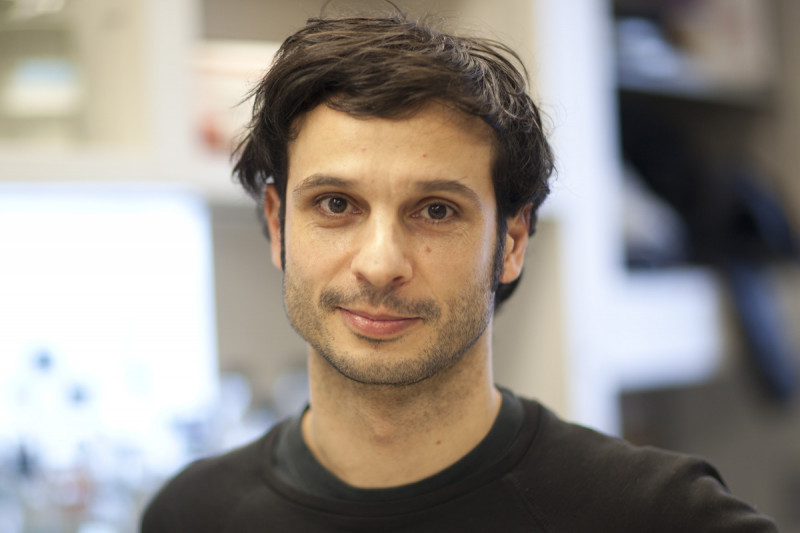
Federico Gonzalez studied Biology at the University of Geneva where he got his PhD in the Laboratory of Molecular Embryology of Prof. Denis Duboule. His work focused on the regulation of 5’ Hoxd genes during limb development and lead to the identification of a new class of remote enhancer elements able to establish regulatory landscapes over extended multigenic genomic loci named global control regions (GCR). The discovery of such elements had important implications on the way tetrapod evolution can be understood.
In 2007, he moved to the Salk Institute for Biological Studies, in the laboratory of Juan Carlos Izpisua Belmonte, where his work concentrated in the development of new strategies to generate induced Pluripotent Stem cells (iPSCs) devoid of permanenent genetic modifications. After joining Juan Carlos Izpisua Belmonte’s team at the Center for Regenrative Medicine in Barcelona (CMRB) in 2008, he showed that transgene-free iPS cell lines can be obtained from mouse embryonic fibrobalsts by simple delivery of a single episomal vector expressing the OSKM set of transcription factors as a polycistronic unit. This report was among the first, which showed the feasibility of generating therapeutically relevant iPSCs.
As Postdoc in the Huangfu lab, based on recent findings arising from the rerogramming field, he plans to investigate a putative role of reprogramming in tumoral processes, using the mouse as a model system.
Selected Publications
Federico González, Stephanie Boué and Juan Carlos Izpisúa Belmonte. Methods for making induced pluripotent stem cells: reprogramming à la carte. (2011). Nature Reviews Genetics. 12 (4):231-42.
Nuria Montserrat*, Elena Garreta Bahima*, Federico González, Jordán Gutiérrez, Cristina Eguizábal, Víctor Ramos Pérez, Salvador Borrós, Juan Carlos Izpisúa Belmonte. (2011). Simple generation of human induced pluripotent stem cells using poly(β-amino esters) as non-viral gene delivery system. J. Biol. Chem. 286 (14):12417-28.
Núria Montserrat, Elena Garreta Bahima, Laura Batlle, Sophia Häfner, Alexandre Miguel Cavaco, Rodrigues, Federico González and Juan Carlos Izpisúa Belmonte. (2010). Generation of Pig iPS Cells: A Model for Cell Therapy. J. Cardiovasc. Transl. 4 (2):121-30.
Rodríguez-Pizà I, Richaud-Patin Y, Vassena R, González F, Barrero MJ, Veiga A, Raya A, Belmonte JC. (2010). Reporgramming of human fibroblasts to induced pluripotent stem cells under xeno-free conditions. Stem Cells. 28 (1): 36-44.
Alessandra Giorgetti, Nuria Montserrat, Trond Aasen, Federico González, Ignacio Rodrıíguez-Pizà, Rita Vassena, Angel Raya, Stéphanie Boué , María José Barrero, Begoña Aran Corbella, Marta Torrabadella, Anna Veiga and Juan Carlos Izpisúa Belmonte. (2009). Generation of Induced Pluripotent Stem Cells from Human Cord Blood Using OCT4 and SOX2. Cell Stem Cell. 5 (4): 353-7.
Ángel Raya, Ignasi Rodrí́guez-Pizà, Guillermo Guenechea, Rita Vassena, Susana Navarro, María José Barrero, Antonella Consiglio, Maria Castellà, Paula Río, Eduard Sleep, Federico González, Gustavo Tiscornia, Elena Garreta, Trond Aasen, Anna Veiga, Inder M. Verma, Jordi Surrallés, Juan Bueren & Juan Carlos Izpisúa Belmonte. (2009). Disease-corrected haematopoietic progenitors from Fanconi anaemia induced pluripotent stem cells. Nature. 460 (7251): 53-9.
Federico Gonzalez, Montserrat Barragan Monasterio, Gustavo Tiscornia, Nuria Montserrat Pulido, Rita Vassena, Laura Batlle Morera, Ignasi Rodriguez Piza, and Juan Carlos Izpisua Belmonte. (2009). Generation of mouse-induced pluripotent stem cells by transient expression of a single nonviral polycistronic vector. Proc Natl Acad Sci USA. 106 (22): 8918-22.
Trond Aasen, Angel Raya, Maria J Barrero, Elena Garreta, Antonella Consiglio, Federico Gonzalez, Rita Vassena, Josipa Bilić, Vladimir Pekarik, Gustavo Tiscornia, Michael Edel, Stéphanie Boué & Juan Carlos Izpisúa Belmonte. (2008) Efficient and rapid generation of induced pluripotent stem cells from human keratinocytes. Nat Biotechnol. 26 (11): 1276-84.
Gonzalez F., Duboule D., Spitz F. (2007). Transgenic analysis of hoxd gene regulation during digit development. Dev Biol. 306 (2): 847-59.
Spitz F., Gonzalez F., Duboule D. (2003). A global control region defines a chromosomal regulatory landscape containing the HoxD cluster. Cell. 113 (3): 278-80.
Spitz F., Gonzalez F., Peichel C., Vogt T.F., Duboule D., Zakani J. (2001). Large scale transgenic and cluster deletion analysis of the HoxD complex separate an ancestral regulatory module from evolutionary innovations. Genes Dev. 15 (17): 2209-14.
